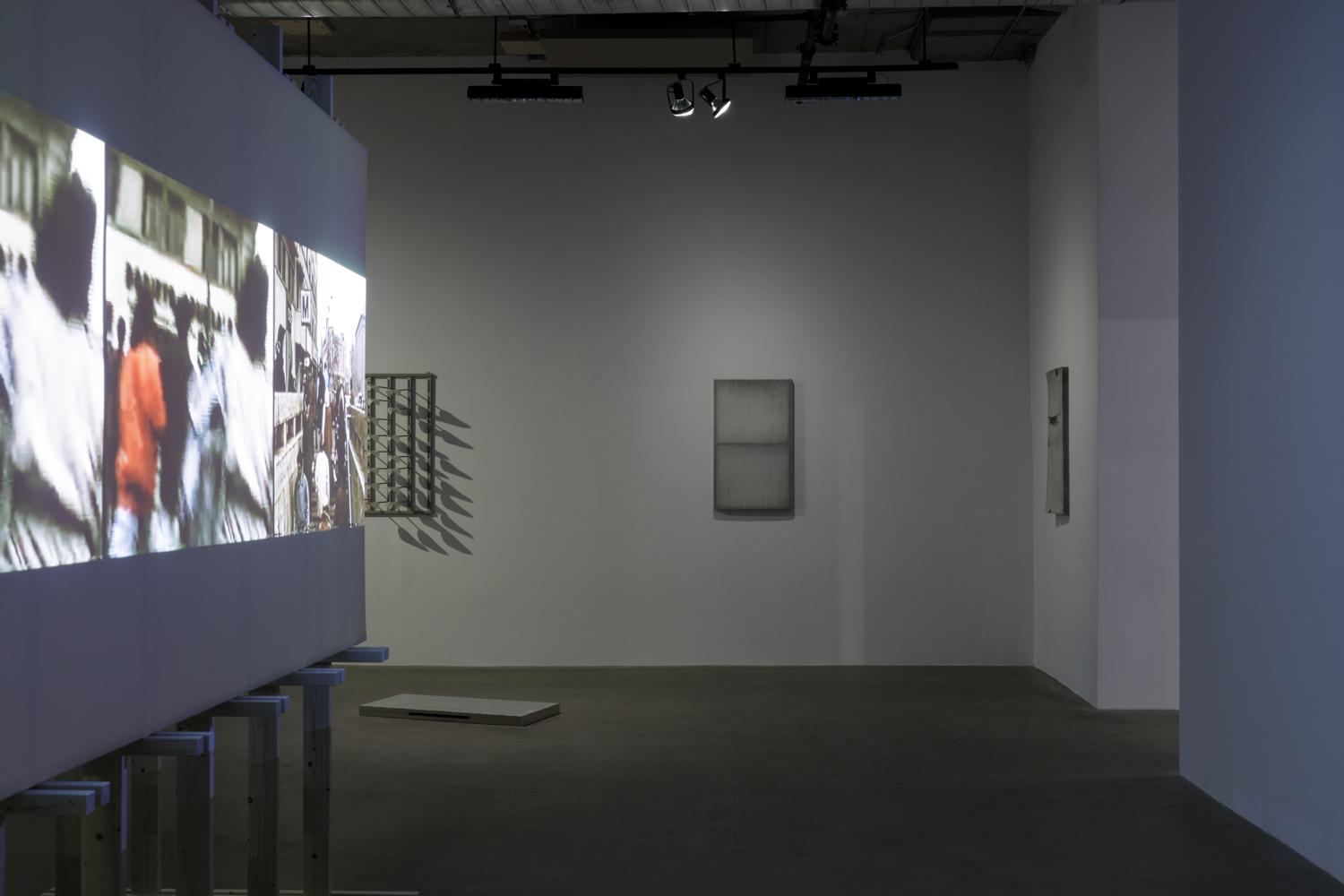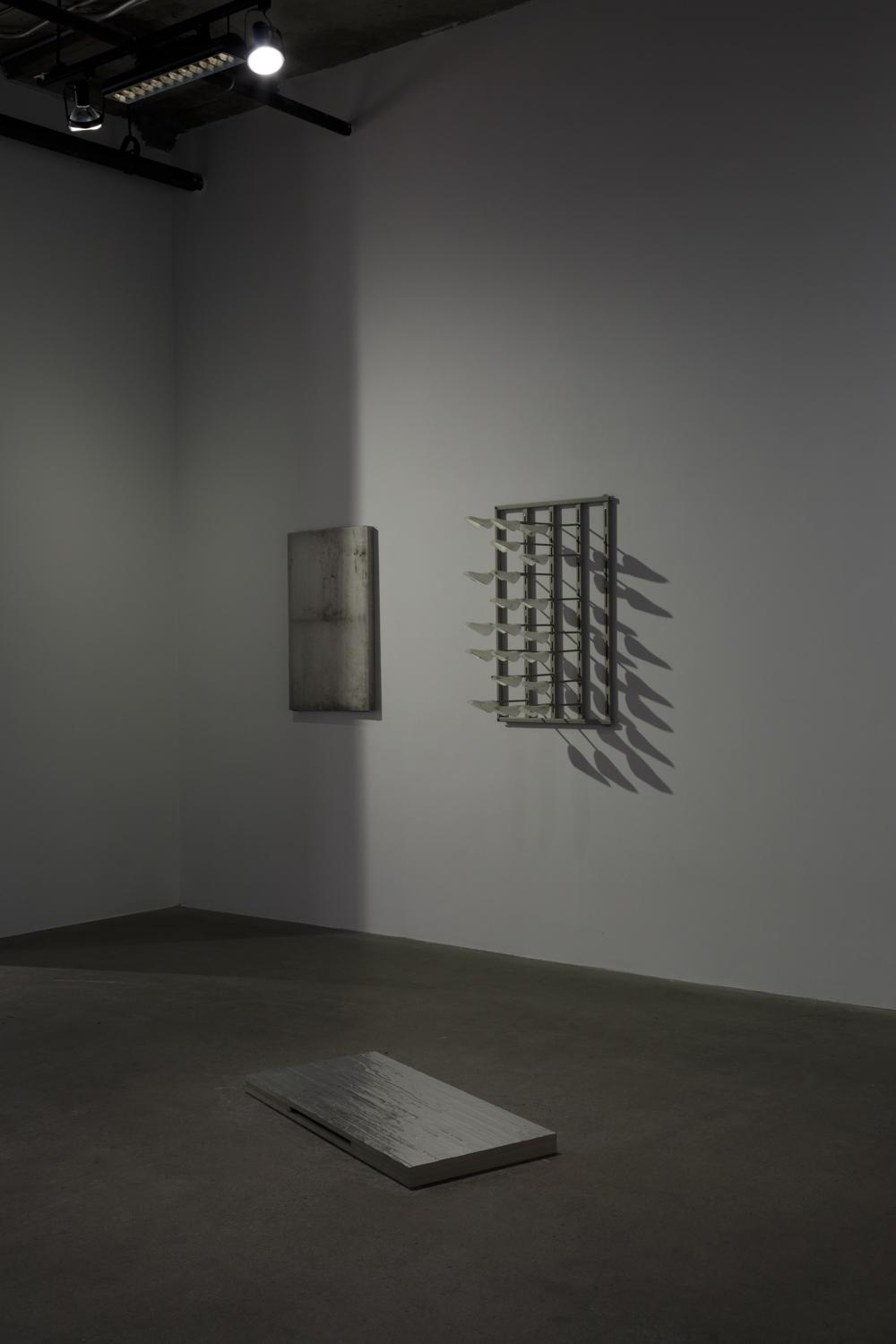
monica maria moraru, The Foundation Pit, 2025, Installation view at Centre Clark, Montréal, 2024. Credit: Document original.
Throughout the Balkans and Southeastern Europe there is a popular folktale that describes the tragic, sacrificial immurement of a woman to ensure the successful construction of a building. From Albania to Georgia, around 700 variations of the myth exist, including “The Bridge of Arta” in Greece, “The Building of Skadar” in Serbia, “Clement Mason” in Hungary, and “Master Builder Manole” in Romania. Though the constructions in these tales vary from bridges, to fortresses, to monasteries, they share the same basic narrative: a man sacrifices a woman against her will in order to create the foundation upon which a structure can be built. Romanian-born artist and filmmaker monica maria moraru recently explored the Master Builder Manole myth in her exhibition The Foundation Pit. In the exhibition, moraru not only revisits the myth and its cultural influence but also considers the intertextual links between the sacrifice-for-construction myth and the literary work from which the exhibition derived its title: Soviet writer Andrei Platonov’s novel The Foundation Pit.
In 1852, Romanian poet Vasile Alecsandri published the ballad “Mănăstirea Argeșului” (“Argeș Monastery”) in the collection Balade, adunate și îndreptate de V. Alecsandri (Ballads, collected and edited by V. Alecsandri), effectively popularizing the Manole myth and transforming the traditional oral tale into a canonical Romanian text. The ballad describes the construction of the Curtea de Argeș Monastery, built between 1515 and 1517. In the ballad, Meșterul Manole (Master Builder Manole) and a team of workers are commissioned by the Prince Negru Vodă to construct a church upon an old foundation, but every morning they awake to find the previous day’s work collapsed. One night, a voice comes to Manole in a dream, whispering that the church will only stand should they immure a woman they love within the walls. Manole awakens the following morning and sees his pregnant wife Ana approaching from the horizon. When she appears, the masons begin to build around her, encasing her—his loving and dutiful Ana—within the walls. When the Prince arrives to admire their work, he traps Manole and his workers on the roof, afraid they will replicate the masterpiece. The ballad ends as Manole and his workers craft wings out of wood and, one by one, attempt to fly off the roof only to fall to their deaths, as Ana’s voice calls out from the walls. Today, the Curtea de Argeș Monastery still stands, and on its grounds lies a fountain in Manole’s honor. On an exterior wall, a red inscription, a combination of Old Slavonic and Romanian, allegedly marks Ana’s resting place.
What fantasies do we project onto the architecture that surrounds us? And what fantasies does the architecture project back?
At the center of moraru’s exhibition is an architectural structure, a precise wooden frame of posts and beams onto which she projects a film: fragments, glimpses like memory, a blurred vision seen in double. Crystal cut glasses, empty church pews, a crowd, a railway; all reflected and refracted (watching these fragments flicker, I’m reminded of Boris Smelov’s Still Lives, of lead glass and dark wood reflected in silvery mirrors). Between the projections there is an empty space, a gap in the frame, a place for the body—or a place where Ana might stand devoutly as the stones pile up around her—and on the walls, corrugated plastic sheets evoke the dirty windows of abandoned structures, or the construction tarps that shroud the scaffolds of worksites. A metal truss holds up a wing of plastic toe caps, their shadows like Manole’s ghost. With poetic intuition, moraru’s work sets the stage for the ballad, all the pieces squarely in position. Watching the video, the static overlay glitching over scenes of an overgrown construction, moraru invites us to ask: what are those wielding ideology or power willing to sacrifice in order to cement their own creations? What cosmogonic myth is anchored into a spire, a vault, a pediment or a dome? What fantasies do we project onto the architecture that surrounds us? And what fantasies does the architecture project back?
Completed in 1930, Andrei Platonov’s novel The Foundation Pit is concerned with another construction, one immured not with a physical body but with an ideology: an immense building to house all the Soviet Union’s proletarians. Written as a critique of Joseph Stalin’s forced collectivization program, which occurred between 1928 and 1940, Platonov’s novel follows a group of laborers as they dig out a massive, ever-expanding foundation pit. As they dig deeper into the soil, the workers’ impossible task causes them to lose sight of the meaning of their work and they descend into violence. The novel, popularly interpreted as a parable, highlights the tension between the state and its workers. Though Platonov was a critic of Stalin’s brutal and repressive policies, he was a firm believer in socialism as a necessary opponent to fascism. Ultimately, he believed technology and over-production to be at the root of the first socialist tragedy. Reading the novel against the Manole myth, we can interpret collectivization as a creation that required sacrifice and even death to be realized. The Foundation Pit is Stalin’s Monastery, his workers sacrificed “according to the same stooped method, through the endurance of a body digging the earth in order to plant into a fresh abyss an eternal stone root of indestructible architecture.” As poet Paul Celan once wrote,
They dug and dug, thus did
their day go, their night. And they did not praise God,
who, so they heard, wanted all this,
who, so they heard, knew all this.
In his analysis of the Master Builder Manole ballad and other construction myths, historian of religion Mircea Eliade writes that, in these folktales, “nothing can last if it is not endowed with ‘life’ and ‘soul’ through the sacrifice of another life.” Canonical readings of the Manole myth in Romanian literary discourse have tended to follow this cosmogonic reading of sacrifice as creation, birth or origin; though after 1989, Romanian feminist scholars also focused on Ana’s gendered role within the ballad. The cosmogonic interpretation served a certain ideological purpose during the communist period (1947-1989) as Romania’s constitutive myth, wherein personal sacrifice and struggle were represented as a necessary aspect of creation. Olga Bartosiewicz-Nikolaev, examining the myth in Romanian school curricula, noted that a 1953 curriculum highlighted “the historical context of the legend, the creative power of the Romanian people, their industriousness and willingness to make sacrifices in the name of workers’ duty,” effectively embedding the myth into the notion of class struggle. Of course, personal sacrifice for the collective body isn’t inherently bad, nor violent. But in totalitarian societies, such as President Nicolae Ceaușescu’s Romania, “The citizenry were turned into Anas through the experience of being inculcated with the view of supererogation as self-sacrifice and duty, and through the ordeal of their self-creation in the walls of monuments built for the glory of a totalitarian megalomanic [sic] regime.” In both texts, architecture becomes a duty and sacrifice an imposition, a necessity. In both texts, architecture envelops the soul and the body and sacrifices it to social order, cementing social authority in its eternal stone roots, morality in its dome or spire.
In moraru’s video, a crowd of people file in and out of a metro station, cobbling onto a Bucharest street. The buildings are cold and elegant in the eclectic style, a coalescence of Art Deco, Art Nouveau, Neoclassical and Romanian Revival. A woman in grey struggles through a crowd of men, multiple bags on her arm, a scarf covering her head from the cold. Perhaps she is trying to catch the red bus driving by, trying to get home. In 1982, demolition began in Bucharest to make way for Romania’s Palace of Parliament (Ceaușescu’s Palace of Parliament). 40,000 citizens were displaced, the Uranus neighborhood flattened with all its homes, roads, factories, workshops, churches and schools. Seven square kilometers of Bucharest were razed to construct the Palace, now the heaviest building (at 4,098,500 tons) and most expensive administrative building (at €4 billion) on Earth. Construction required craftsmen, builders, soldiers and forced laborers by the tens of thousands—and perhaps, like Manole and his masons, some of them crafted wings. Concrete, metal and rock outlive human life and transcend the confines of history; this is why the built environment is often the egotist’s playground, why Ana felt the crushing weight of the stones on her body, why Platonov’s Pit was never ending, why Ceaușescu erased endless city blocks from the map. The Palace, the Monastery and the Pit all attempt to cement power—a higher power, a royal power, a political power—and preserve its memory. They preserve myths of nationalism, myths of grandiosity, myths of imperial aspirations.

.jpg)

Installation view. monica maria moraru, The Foundation Pit at Centre Clark, Montréal, 2024. Credit: Document original
In a sense, through her exploration of the Master Builder Manole myth, moraru’s work inserts itself into wider conversations about sacrifice-as-construction beyond the myth and Platonov’s novel. Recent exhibitions in Romania at the National Museum of Contemporary Art (ironically housed in the Palace of Parliament) have highlighted and mapped out what was lost to build power into stone, or those missing seven square kilometers of Bucharest. Ioana Marinescu’s recent work Deal. Reconstituire (Hill. Reenactment) performs a topographic reconstruction of Arsenal Hill, sacrificed to make way for the Palace, while the project URANUS NOW and the online community Uranus District attempt to recreate, reenact and preserve the memory of the Uranus neighborhood that was destroyed. Like moraru’s work, they explore individuals’ and communities’ forced sacrifices in the name of power and totalitarian glory, and the shadows that lie buried somewhere beneath it all.
Now, considering the Pit and the Monastery, we might say those who wield ideology or power are willing to sacrifice their workers and their Anas, their buildings and their neighborhoods for creation. Then we might say that creation and construction are analogous, and notice that the word edifice refers to something that is both material and abstract. And one day, you might find yourself in the city, an ear pressed against a wall, listening closely for a sound, for a memory that might break through the rock. You open a map, and trace the path from one sacrifice to another, from the Monastery to the Palace. The trajectory is simple: you follow Bulevardul Basarabilor (our Prince Negru Vodă’s successor), turn left on Strada 1 Decembrie 1918 (Romania’s Great Union Day) and continue straight down Strada 1 Mai (International Workers' Day). You take the A1 motorway for an hour or so, glimpsing scenes as they flit by outside the window, surfaces glistening in the sun, its rays catching the occasional cross on the side of the road. You remember moraru’s film: a railway, a church, a man hailing a cab, a woman wearing grey.